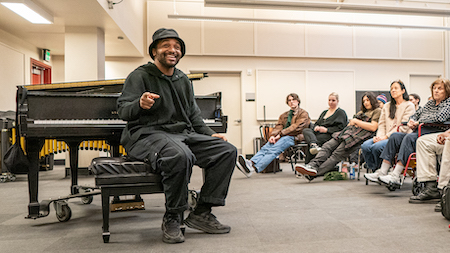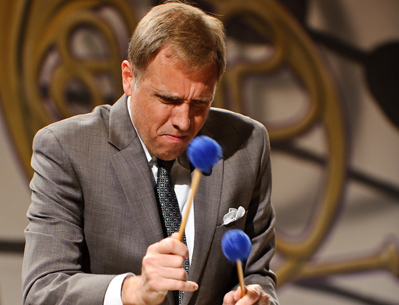Dec 9, 2025 12:28 PM
In Memoriam: Gordon Goodwin, 1954–2025
Gordon Goodwin, an award-winning saxophonist, pianist, bandleader, composer and arranger, died Dec. 8 in Los Angeles.…

Pianist Sullivan Fortner, who performed at the Old Church with bassist Tyrone Allen and drummer Kayvon Gordon, leads a clinic during the PDX Jazz Festival.
(Photo: Courtesy Portland Jazz Festival)To get from one’s car to the Old Church, a beautifully refurbished old building in a corner of Portland, Oregon’s compact downtown, one must pass near an open-air fentanyl market. It is not necessarily as dangerous as it sounds, but it is not pleasant.
So give credit to the Portland Jazz Festival, presented by PDX Jazz, for booking the kind of acts that keep dedicated jazz lovers coming back. Of the five shows booked into the Old Church during this year’s edition, two sold out, and at least one other came close. The Old Church, which seats 300, was one of 13 venues hosting 29 acts over the course of 15 days, not including daytime community events, which are free. The festival, which celebrated its 20th anniversary last year, has survived previous financial crises, a virtual-only year during the pandemic and bouts of bad weather, and it will survive the depressing mess in downtown Portland. Attendance is not yet back to pre-pandemic levels, but seven of this year’s events sold out, including headliner Jon Batiste’s opening-night concert in the 2,800-seat Arlene Schnitzer Concert Hall, and the Bob James/Lee Ritenour show in the 880-seat Newmark Theater.
Since 2020, when Chris Doss assumed executive leadership of the festival and Nicholas Salas-Harris was hired as artistic director, PDX Jazz has broadened its programming to include more of what it calls “jazz adjacent” music. The goal is admirable: to bring in younger listeners and diversify the audience, not to mention sell tickets. In terms of artistic quality, however, the results have been mixed. African music, funk, blues and zydeco — cool. Dance club DJs and internet sensations, sometimes not so much.
In the festival’s second week, Feb. 19–23, I saw five extraordinary shows; four were extraordinarily good, one extraordinarily bad. Pianist Sullivan Fortner, who appeared at the Old Church with his trio of bassist Tyrone Allen and drummer Kayvon Gordon, should be more famous than he is. Best-known as an accompanist to Cécile McLoren Salvant, Fortner has old school/new school chops recalling everyone from Art Tatum and Thelonious Monk to Keith Jarrett. He is still in the process of defining his identity as recording artist and bandleader, but his two-hand stride technique is jaw-dropping, and his unassuming manner is charming. Highlights included a calypso-inflected version of Charles Trenet’s “La Mer” and an elegant reading of Hoagy Carmichael’s standard “Stardust.” Toward the end of the set, Fortner brought up saxophonist Nicole Glover, a former Portlander now playing with the band Artemis, who was in town for a show of her own the night before.
Bassist John Patitucci closed the festival with a sold-out show at the Old Church featuring his trio of guitarist Yotam Silberstein and drummer Rogerio Boccato playing classic Brazilian songs by Djavan, Milton Nascimento, Ivan Lins and others. (The same group had performed the night before under Silberstein’s leadership.) Patitucci is both a master of tone on the double-bass and the best electric bass guitar soloist since Jaco Pastorius. His fleet-fingered exchanges with Silberstein on the electric instrument and unaccompanied acoustic solo provided a satisfying finale to this year’s festival.
In the mid-week, guitarist Julian Lage delivered another impeccable trio set in the sold-out Revolution Hall, at 800 seats the largest of the festival venues located across the river on the city’s east side. With bassist Jorge Roeder and drummer Joey Baron, Lage mostly featured music from his latest album Speak To Me. The audience sat transfixed for more than an hour, as Lage alternated ripping, rock-edged runs containing trebly echoes of surf guitar with gently melodic meditations on more standard jazz changes. Baron gave a master-class in restraint before finally busting loose with a crashing solo. Dan Balmer, who has been the foremost jazz guitarist in Portland for 40 years, opened with a set of more conventional jazz fusion. Most of the program was taken from his latest album, When The Night, but the highlight was a piece dedicated to the late Native American saxophonist Jim Pepper, who served as a mentor to Balmer in the late 1970s and early ’80s.
For my money (and yes, I did buy tickets), the week’s finest performance was turned in by vocalist Dianne Reeves at Revolution Hall. Reeves has not released a new album in 10 years, and the room was only about half-full, but if Reeves was at all bothered it did not show. Backed by a superb band including Romero Lubambo on guitar, John Beasley on keyboards, Reuben Rogers on bass and Terreon Gulley on drums, Reeves sat on a stool and delivered a finely calibrated set that ranged from Fleetwood Mac’s “Dreams,” Betty Carter’s “Social Call” and Milton Nascimento’s “Ponta de Areia” to her own crowd-pleasing story-songs “Nine” and “Better Days.” Her voice was in flawless form, and as at all of the above shows, the sound engineers were up to the task of adapting to the acoustics of the hall.
The contrast between Reeves’ artistry and dignity and what took place the next night in the ballroom at the Portland Art Museum could not have been more sharply delineated. The festival’s program guide described Sudan Archives’ music as “left-field strains of R&B, hip-hip, folk and electronic music with the fiddling styles of West Africa,” and her album Natural Brown Prom Queen came in No. 2, behind Beyonce, in Pitchfork’s 2022 top albums list. What that amounted to onstage was a young woman wearing a skimpy leotard and a thong, jumping around to a throbbing electronica beat and waving her ass in the faces of the front row while shouting out catch phrases, some of which should not be repeated here. The violin, which she can barely play, was used mostly as a prop. True, the show brought in a younger, more diverse crowd, some of whom were dancing and may have even enjoyed the spectacle. And I’m hardly a jazz purist. But other than opening act Melanie Charles, who can actually sing, I’d say this act was more “strip-club adjacent” than “jazz adjacent,” only louder. DB

Goodwin was one of the most acclaimed, successful and influential jazz musicians of his generation.
Dec 9, 2025 12:28 PM
Gordon Goodwin, an award-winning saxophonist, pianist, bandleader, composer and arranger, died Dec. 8 in Los Angeles.…

Belá Fleck during an interview with Fredrika Whitfield on CNN.
Jan 13, 2026 2:09 PM
The fallout from the renaming of the John F. Kennedy Center for the Performing Arts to include President Donald…

Flea has returned to his first instrument — the trumpet — and assembled a dream band of jazz musicians to record a new album.
Dec 2, 2025 2:01 AM
After a nearly five-decade career as one of his generation’s defining rock bassists, Flea has returned to his first…

Dec 11, 2025 11:00 AM
DownBeat presents a complete list of the 4-, 4½- and 5-star albums from 2025 in one convenient package. It’s a great…

Vibraphonist Chuck Redd found himself in the midst of a political firestorm after canceling his gig Dec. 24 at the newly renamed Trump Kennedy Center.
Jan 6, 2026 2:32 AM
The Board of Trustees at Washington, D.C.’s Kennedy Center for the Performing Arts voted on Dec. 18 to rename the…